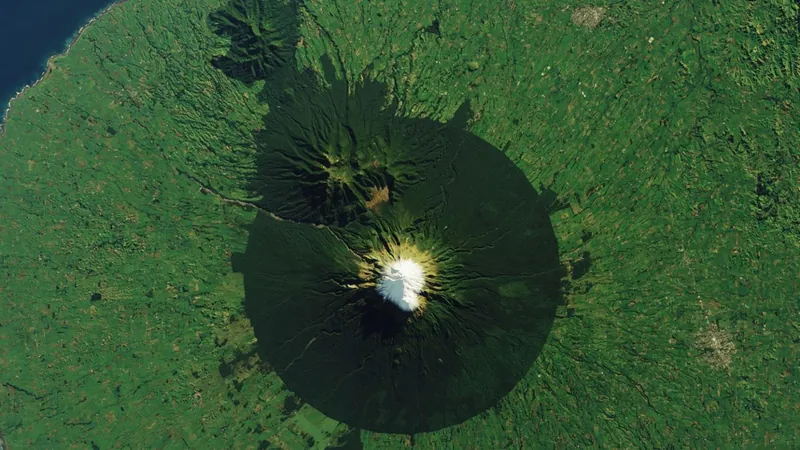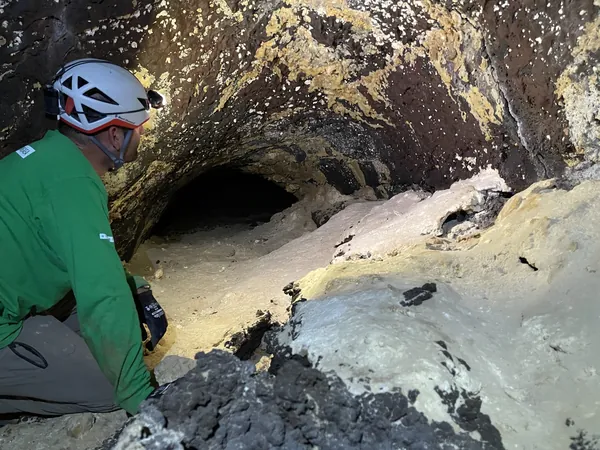
Discovering New Zealand's Enigmatic 'Goblin Forest' and Its Sacred Volcano
2024-11-19
Author: Daniel
Mount Taranaki: Nature’s Awe-Inspiring Marvel!
A breathtaking satellite image taken on June 10, 2023, showcases the stunning Mount Taranaki volcano, surrounded by a mysterious and eerily circular forest famously known as the "Goblin Forest." Captured by the Landsat 8 satellite, this image reveals the striking snow-capped peak of a sacred volcano that holds a special place in the hearts of the local Māori tribes of New Zealand.
Location and Facts to Know:
- **Where:** Egmont National Park, New Zealand - **Coordinates:** [-39.3019245, 174.0631103] - **Height:** Approximately 8,261 feet (2,518 meters), making it the second-highest peak in New Zealand.
Mount Taranaki, originally named Mount Egmont by British explorer James Cook during his travels in the 18th century, is an active stratovolcano located on the lush west coast of New Zealand's North Island. The nearly perfect ring of dark green surrounding its majestic slopes is part of Egmont National Park, which spans roughly 12 miles (19 kilometers) across at its widest point.
The forest is primarily composed of two remarkable species of evergreen trees: the rimu (Dacrydium cupressinum) and kīmahi (Pterophylla racemosa). The particular section of kīmahi trees near the volcano's summit has gained attention for its bizarre, twisted formations, resulting in the ominously charming nickname, the "Goblin Forest." These trees have contorted shapes due to their struggle to grow over fossilized remains of their predecessors, casualties of past volcanic eruptions. Adding to the forest's haunting beauty, the trees are adorned with hanging mosses and liverworts, enhancing their goblin-like appearance.
Interestingly, Mount Taranaki is not just a geological wonder; it carries significant cultural weight. In 2017, the New Zealand government recognized its deep-rooted cultural significance by granting it legal personhood, equating its protection to that of a human being. This decision acknowledges the profound relationship that the Indigenous Māori people hold with the mountain, viewing it as an ancestor worthy of the same respect—any harm to the mountain parallels harm to their community.
Cinematic Connections and Ongoing Transformations
The volcano’s symmetrical cone has earned it a place in cinematic history, serving as a stand-in for the iconic Mount Fuji during the filming of the 2003 epic, "The Last Samurai." However, despite its stunning form, Mount Taranaki's landscape has evolved through a series of dramatic changes and eruptions since its formation approximately 135,000 years ago. A 2021 study revealed that it has experienced at least 16 significant deformations due to volcanic activity, illustrating the dynamic nature of this majestic giant.
The Goblin Forest and Mount Taranaki stand as a testament to the raw beauty and remarkable cultural significance of New Zealand’s natural landscapes. With continued interest from scientists and tourists alike, these striking features are sure to captivate the imagination for generations to come.



 Brasil (PT)
Brasil (PT)
 Canada (EN)
Canada (EN)
 Chile (ES)
Chile (ES)
 España (ES)
España (ES)
 France (FR)
France (FR)
 Hong Kong (EN)
Hong Kong (EN)
 Italia (IT)
Italia (IT)
 日本 (JA)
日本 (JA)
 Magyarország (HU)
Magyarország (HU)
 Norge (NO)
Norge (NO)
 Polska (PL)
Polska (PL)
 Schweiz (DE)
Schweiz (DE)
 Singapore (EN)
Singapore (EN)
 Sverige (SV)
Sverige (SV)
 Suomi (FI)
Suomi (FI)
 Türkiye (TR)
Türkiye (TR)